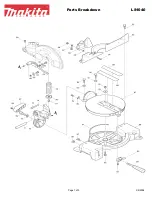
5 − English
ADDITIONAL SAFETY RULES
Inspect tool cords periodically.
If damaged, have re-
paired by a qualified service technician at an authorized
service facility. Repair or replace a damaged or worn cord
immediately. Stay constantly aware of cord location and
keep it well away from the rotating blade.
Inspect extension cords periodically
and replace if
damaged.
Polarized plugs.
To reduce the risk of electric shock,
this tool has a polarized plug (one blade is wider than
the other). This plug will fit in a polarized outlet only one
way. If the plug does not fit fully in the outlet, reverse the
plug. If it still does not fit, contact a qualified electrician
to install the proper outlet. Do not change the plug in any
way.
Know your power tool.
Read the operator’s manual
carefully. Learn the applications and limitations as well
as the specific potential hazards related to this tool.
Always wear eye protection with side shields which
is marked to comply with ANSI Z87.1 when using this
product.
Failure to do so could result in objects being
thrown into your eyes, resulting in possible serious injury.
Never stand on tool.
Serious injury could occur if the tool
is tipped or if the cutting tool is unintentionally contacted.
Keep guards in place
and in good working order.
Use the right direction of feed.
Feed work into a blade,
cutter, or sanding spindle against the direction of rotation
of the blade, cutter, or sanding spindle only.
Never leave tool running unattended. Turn the power
off.
Don’t leave tool until it comes to a complete stop.
Use only correct blades. Do not
use blades with incorrect
size holes. Never use blade washers or blade bolts that
are defective or incorrect. The maximum blade capacity
of your saw is 10 in.
Before making a cut, be sure all adjustments are
secure.
Never touch blade
or other moving parts during use.
Double check all setups.
Make sure blade is tight and
not making contact with saw or workpiece before con-
necting to power supply.
Firmly clamp or bolt
your tool to a workbench or table
at approximately hip height.
Make sure the miter table and saw arm (bevel func-
tion) are locked in position before operating your saw.
Lock the miter table by pushing the miter lock lever down.
Lock the saw arm (bevel function) by securely tightening
the bevel lock knob.
Never move the workpiece or make adjustment to any
cutting angle while the saw is running and the blade
is rotating.
Any slip can result in contact with the blade
causing serious personal injury.
Avoid
awkward operations and hand positions
where a
sudden slip could cause your hand to move into the blade.
ALWAYS
make sure you have good balance.
NEVER
operate your miter saw on the floor or in a crouched
position.
Never
stand or have any part of the body in line with the
path of the saw blade.
Do not turn the motor switch on and off rapidly.
This
could cause the saw blade to loosen and could create
a hazard. Should this ever occur, stand clear and allow
the saw blade to come to a complete stop. Disconnect
your saw from the power supply and securely retighten
the blade bolt.
If any part of this miter saw is missing
or should break,
bend, or fail in any way, or should any electrical compo-
nent fail to perform properly, shut off the power switch,
remove the miter saw plug from the power source and
have damaged, missing, or failed parts replaced before
resuming operation.
Always turn off the saw
before disconnecting it to avoid
accidental starting when reconnecting to power supply.
NEVER
leave the saw unattended while connected to a
power source.
This tool
should have the following markings:
• To reduce the risk of injury, user must read the opera-
tor’s manual.
• Wear eye protection.
• Keep hands and body out of the path of the saw blade.
Contact with the blade will result in serious injury.
• Check guarding system to make sure it is functioning
correctly.
• Do not perform any operation freehand.
• Never reach around the saw blade.
• Turn off tool and wait for saw blade to stop before
moving workpiece or changing settings.
• Disconnect the saw from the power source before
changing blade or servicing.
Always
carry the tool only by the carrying handle.
This saw can tip over
if the saw head is released sud-
denly and the saw is not secured to a work surface. Always
secure this saw to a stable work surface before any use
to avoid serious personal injury.
Always make sure the saw blade has clearance of
all obstructions before turning the saw on.






































